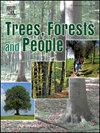Fagus grandifolia growth and mortality a decade after the emergence of Beech leaf disease
IF 2.7
Q1 FORESTRY
引用次数: 0
Abstract
Beech leaf disease (BLD) is poised to cause major declines in American beech (Fagus grandifolia) across the eastern United States and parts of Canada. Given the dominance of this tree, quantifying impacts of this emerging disease is critical. Using long-term data from an existing field experiment (originally established to explore the impacts of soil chemistry on forests), we quantify rates of mortality and growth in American beech afflicted with BLD near the disease's epicenter. Since the initial observation of BLD in Cuyahoga County, OH in 2014, 75 of the 263 (29 %) American beech trees within our study have died. Most of this mortality was recent, with 2021–2023 displaying the highest levels of beech mortality (56 trees dying across the three years). Mortality was distributed unevenly across size classes, with the highest rates of mortality occurring in trees <25 cm DBH. Mortality rates were influenced by beech abundance, suggesting that areas with high concentrations of beech may experience higher rates of mortality. In addition, beech grew more slowly in recent years (2017–2022), suggesting a probable slowing of growth rates associated with BLD. Further, we observed lower growth rates in plots with the addition of soil amendments, but only before the arrival of BLD. As a dominant tree in many forests, this decline in American beech could catalyze larger stand-level changes in forest composition and function as BLD persists on the landscape and continues to spread into new areas.
山毛榉叶病出现后10年山毛榉的生长和死亡率
山毛榉叶病(BLD)已准备好导致美国山毛榉(Fagus grandfolia)在美国东部和加拿大部分地区的大量下降。鉴于这种树的优势地位,量化这种新出现的疾病的影响至关重要。利用现有野外实验(最初是为了探索土壤化学对森林的影响而建立的)的长期数据,我们量化了疾病中心附近受BLD影响的美洲山毛榉的死亡率和生长率。自2014年在俄亥俄州凯霍加县首次观察到BLD以来,我们研究的263棵美国山毛榉树中有75棵(29%)已经死亡。这种死亡率大部分是最近发生的,2021-2023年山毛榉死亡率最高(三年内有56棵树死亡)。死亡率在不同大小类别中分布不均匀,以25 cm胸径的树木死亡率最高。死亡率受到山毛榉丰度的影响,这表明山毛榉浓度高的地区可能会有更高的死亡率。此外,近年来(2017-2022年),山毛榉的增长速度更慢,这表明与BLD相关的增长率可能放缓。此外,我们观察到添加土壤改良剂的地块生长速率较低,但仅在BLD到来之前。作为许多森林中的优势树种,美洲山毛榉的减少可能会催化森林组成和功能的更大的林分水平变化,因为山毛榉在景观上持续存在并继续向新的地区扩散。
本文章由计算机程序翻译,如有差异,请以英文原文为准。
求助全文
约1分钟内获得全文
求助全文
来源期刊

Trees, Forests and People
Economics, Econometrics and Finance-Economics, Econometrics and Finance (miscellaneous)
CiteScore
4.30
自引率
7.40%
发文量
172
审稿时长
56 days
 求助内容:
求助内容: 应助结果提醒方式:
应助结果提醒方式:


